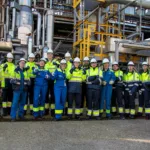INDUSTRY IN SECTORS
The 20th century was characterized by immense growth and diversification in the chemical industry. World Wars I and II accelerated chemical research and production, leading to the development of new materials and processes. Today, the chemical industry is a global powerhouse, encompassing a wide range of sectors and technologies. It continues to evolve, driven by innovations in sustainability, digitalization, and interdisciplinary research.
The building blocks of today’s chemical industry: petrochemicals, specialty chemicals, and halogens sectors explained
The chemical industry is one of the most diverse and vital sectors in modern society, contributing to virtually every aspect of daily life and technological advancement. It covers a wide range of activities, from producing bulk chemicals used in large-scale industrial processes to creating highly specialised compounds for precision applications. The industry relies on a vast array of feedstocks—including fossil fuels, minerals, bio-feedstocks, and naturally occurring substances—each providing essential building blocks for sectors like pharmaceuticals, agriculture, energy, and consumer goods.
This diversity is reflected in the structure of Cefic, which is organised into three major industry clusters: Petrochemicals Europe , Specialty Chemicals , Halogens . Each cluster includes specific sector groups focused on particular substances and applications, ensuring a well-rounded approach to advancing technology, innovation, and regulatory standards across the industry.

Specialty Chemicals
Whereas petrochemicals are produced in bulk, specialty chemicals are typically synthesised through complex chemical reactions, using various feedstocks including refined petrochemical products and naturally occurring substances. Produced in smaller quantities, specialty chemicals cater to specific, high-value applications, such as additives, adhesives, dyes, and coatings. Sectors like healthcare, agriculture, and electronics rely on specialty chemicals for precise performance and tailored solutions, driving innovation from crop protection to advanced materials in pharmaceuticals and electronics. The Specialty Chemicals industry group within Cefic represents over 50 sector-specific groups of the European fine and consumer chemicals industry.

Marc Vermeulen
Cefic — Executive Director Specialty Chemicals & Ad Interim Executive Director of Petrochemicals Europe
Halogens
The Halogens industry sector focuses on reactive chemicals such as chlorine, fluorine, and bromine, extracted from natural sources like salt deposits, fluorite, and seawater. These highly reactive elements form the basis for a wide range of industrial chemicals used in water purification, pharmaceuticals, refrigeration, and electronics. For example, chlorine is produced via the electrolysis of brine, while fluorine is obtained from minerals like fluorite. Halogens play a critical role in environmental protection, clean energy technologies, and the production of life-saving medical treatments. The Halogens industry group within Cefic includes around 10 sector-specific groups representing companies producing halogens in Europe.

Marleen Pauwels
Cefic — Executive Director Halogens and Executive Director Health, Safety & Environment (HSE), Responsible Care, and Supply Chain
Petrochemicals Europe
Petrochemicals are derived from refinery byproducts and natural gas processing. These materials are “cracked” into essential monomers such as ethylene, propylene, and benzene, which are the foundation of products like plastics, synthetic fibers, resins, and elastomers. Petrochemicals provide critical materials for industries like packaging, automotive, construction, pharmaceuticals, and electronics, enabling everything from renewable energy technologies and electronics to consumer and industrial products.

Marc Vermeulen
Cefic — Executive Director Specialty Chemicals & Ad Interim Executive Director of Petrochemicals Europe












